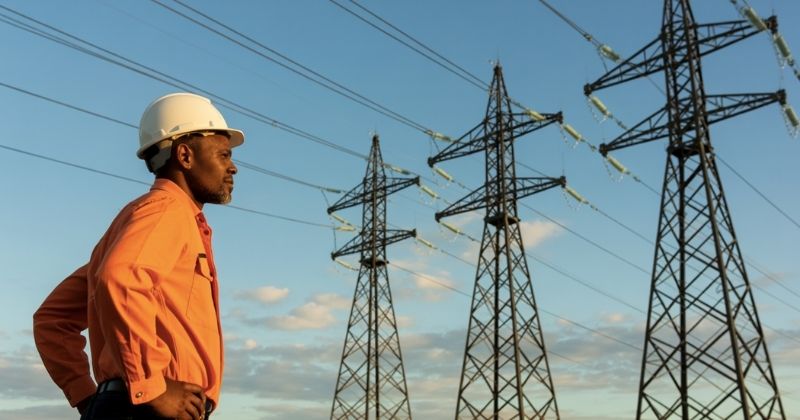
Load shedding has become a persistent and disruptive feature of everyday life in South Africa, affecting households, businesses, and public infrastructure alike. With electricity demand frequently outpacing supply, South Africans face scheduled power cuts that can impact everything from food storage and home security to productivity and communication. Beyond the inconvenience, load shedding brings real financial consequences; damaged appliances, increased fuel and generator costs, and potential income loss for those working from home or in energy-dependent sectors.
Key Takeaways
- Load Shedding Is a Planned but Disruptive Necessity: South Africa experiences scheduled power cuts, managed by Eskom, to prevent grid failure when electricity demand exceeds supply. These outages, ranging from Stage 1 to Stage 8, affect daily life and come with financial and practical consequences.
- Financial Preparation Helps Households Cope Better: Creating a clear budget, automating savings, and keeping emergency funds separate are essential strategies to stay financially stable during ongoing power disruptions. Even small, regular contributions to savings can provide a buffer in emergencies.
- Practical Measures Can Reduce Risk and Inconvenience: From installing backup batteries and using gas for essential needs to securing properties and unplugging appliances, households can take specific steps to manage safety, communication, and comfort during outages. Keeping devices charged and emergency contacts accessible is also crucial.
About Arcadia Finance
Secure your loan quickly and easily with Arcadia Finance. Compare offers from 19 NCR-accredited lenders, pay no application fees, and enjoy a simple, transparent process designed around your financial needs.
What Is Load Shedding?
Load shedding refers to scheduled power outages that occur in designated areas for a limited time when electricity demand surpasses the available supply. Unlike sudden blackouts caused by weather events or technical problems, these outages are planned and managed by the electricity provider, typically Eskom in South Africa, to prevent the collapse of the national power grid.
To put it simply, when too many households and businesses draw electricity at the same time, the system risks becoming overloaded. To avoid a widespread outage across the country, Eskom temporarily cuts power to selected regions in a rotating pattern, ensuring demand is balanced.
These ongoing power interruptions, commonly referred to as load shedding, have become a regular part of life in South Africa. The outages are implemented in stages, from Stage 1 to Stage 8, with higher numbers indicating longer and more frequent power cuts.

Causes of Load Shedding in South Africa
The main reason for load shedding is straightforward: electricity demand exceeds supply. However, several deeper issues contribute to this ongoing problem:
| Cause | Explanation |
|---|---|
| Aging and Unreliable Power Stations | A large portion of Eskom’s coal-fired power plants are several decades old. Like any ageing infrastructure, they are prone to breakdowns. These outages reduce the national electricity supply, forcing Eskom to limit power distribution to avoid overwhelming the grid. Even newer facilities such as Medupi and Kusile have faced serious technical setbacks, including design defects and maintenance failures, which have worsened the supply shortage. |
| Insufficient Maintenance and Delays in Repairs | Routine maintenance is critical to keeping power stations functioning efficiently. Over the years, Eskom has failed to carry out regular repairs or has completed them late. When several generating units break down at once, as witnessed in early 2025, Eskom is compelled to initiate rolling blackouts while the affected equipment is repaired and emergency reserves are restored. |
| Problems with Coal Supply and Quality | With over 80 percent of South Africa’s power coming from coal, reliable supply is essential. However, poor-quality coal, supply disruptions, and theft have made it increasingly difficult to operate coal stations at full output. In some cases, contaminated coal or logistical issues have led to breakdowns that directly trigger load shedding. |
| Slow Adoption of Renewable Energy | Although solar and wind power are gradually increasing their contribution, they still make up a small portion of the energy mix. Eskom has been slow to incorporate more renewable energy projects, keeping the country reliant on ageing, coal-based infrastructure that cannot meet peak demand reliably. |
| Financial Mismanagement and Operational Issues | Years of mismanagement, corruption, and financial losses have left Eskom in a weakened state. The utility is heavily indebted, limiting its ability to maintain existing plants or invest in new generation projects. This has resulted in underinvestment in critical infrastructure and reduced overall system reliability. |
| Rising Electricity Demand | South Africa’s population growth, along with the expansion of industrial and commercial activity, continues to push up electricity consumption. Unfortunately, new power plants have not been developed at the pace required to meet this increased demand. This imbalance leads to frequent shortages, prompting scheduled outages to stabilise supply. |
| Impact of Climate Change and Severe Weather | The growing impact of climate change brings more frequent droughts, floods, and heatwaves, which strain the energy system. These extreme |

Building a Savings Plan to Cover Load Shedding Costs
If you already have a structured savings strategy in place, you are already ahead of many others. Having a well-planned approach to saving is essential for handling emergencies or sudden financial shocks. Below are five practical tips for saving money consistently.

Begin With a Clear Budget
Creating a budget gives you control over your finances instead of letting your spending dictate your situation. Without a proper budget, it is easy to waste money on unnecessary items, which can add up to significant amounts by month-end.
A reliable budget should be written down and reviewed regularly, whether weekly, fortnightly or monthly. Start by listing your fixed expenses, income, and any financial goals you want to achieve.
Make sure all your necessary costs are covered, then set limits on discretionary spending such as food, leisure, and shopping. Always include savings as a fixed part of your monthly plan.

Set Up Automatic Transfers to Save Without Thinking
Using debit orders is a simple way to ensure you never skip a saving contribution. Choose an amount that suits your income and schedule it to move into your savings account automatically. This method helps remove the temptation to spend before saving.

Adjust Your Savings As Your Income Grows
As your salary increases over time, so should your savings. Review your financial plan from time to time and increase your contributions accordingly. Even small adjustments will have a big impact over the long term. Make saving a habit that grows with your earnings.

Keep Emergency Funds Separate From Everyday Accounts
When your savings sit in the same account as your daily spending money, it becomes easier to spend it impulsively. Keeping your emergency fund in a different bank account reduces the urge to use that money for non-essentials. Out of sight often means out of temptation.

Prioritise Saving Before Anything Else
One of the most effective ways to build up savings is to pay yourself before paying your bills. This means allocating a set amount to your savings account as soon as your salary is paid. Even starting with just R100 can make a difference. Once your fixed expenses are settled, aim to increase your contributions as you can afford to.
Affordable Backup Power Solutions
Load shedding has become a permanent part of life in South Africa, and preparing financially for it means planning for reliable backup power. While many households may assume that only expensive solutions are available, there are options across different budgets that can make daily life more manageable.
Low-Cost Options: Rechargeable Lights, Gas Stoves and UPS Units
For those on a tight budget, small but effective solutions can make a big difference. Rechargeable LED lights are inexpensive, energy-efficient and can last for several hours during an outage. Portable gas stoves are also a cost-effective alternative, allowing families to prepare meals when electric appliances are unusable. Another useful addition is an Uninterruptible Power Supply (UPS) unit, which can keep essential devices such as Wi-Fi routers or laptops running for short periods. While these solutions will not power an entire household, they can reduce disruption at minimal cost.
Medium Investment: Inverters and Battery Systems
For households willing to spend a bit more, inverters paired with batteries offer greater convenience. These systems convert stored battery energy into usable electricity, allowing multiple devices or even a few essential appliances to keep running. The upfront costs are higher, but they are still more affordable than full solar installations. Over time, investing in a well-sized inverter and battery setup can help reduce dependence on grid power, especially if the system can be expanded later.
Long-Term Investment: Solar Power and Hybrid Systems
For those looking for a permanent solution, solar power is the most sustainable option. Installing solar panels with a hybrid system that includes batteries can keep a household powered throughout load shedding while reducing reliance on Eskom in the long run. Although the initial investment is significant, the benefits extend beyond convenience. Families can save on monthly electricity bills, protect themselves from future tariff increases and contribute to a greener environment. Financing options are also increasingly available, making solar installations more attainable for middle-income households.

Maintaining a Steady Income in a Load Shedding Economy
Build a 3 – 6 Month Emergency Savings Buffer
One of the most effective ways to prepare financially for load shedding is to establish an emergency savings fund. Aim to set aside the equivalent of three to six months of living expenses in a separate, accessible account. This buffer allows you to manage unexpected costs such as appliance repairs, food spoilage or higher fuel and data bills without resorting to debt. Even small, consistent contributions each month will add up over time and provide a crucial safety net during prolonged power interruptions.
Explore Side Hustles That Are Less Affected by Power Cuts
Load shedding often disrupts traditional income streams, particularly for freelancers, small business owners and those who rely heavily on electricity. Consider diversifying your earnings with side hustles that are less dependent on constant power. Options may include online tutoring, digital services that can be completed offline and uploaded later, or small-scale businesses such as baking, delivery services or reselling products. By developing an alternative income stream, you can reduce the financial pressure when your main work is disrupted.
Invest in Remote Work Tools (Wi-Fi UPS, Mobile Data Backup)
For employees and entrepreneurs working from home, reliable internet access is essential. A small investment in a Wi-Fi UPS device can keep your router running for several hours during outages. Pair this with mobile data as a backup to ensure you remain connected when fibre or ADSL lines go down. Over time, this modest investment can prevent lost working hours, missed meetings and reduced productivity, all of which directly affect your income. Preparing your digital tools for resilience ensures that your work and cash flow remain steady, even when the lights go out.
Conclusion
Load shedding has become a regular part of life in South Africa, with both immediate disruptions and longer-term financial impacts. Preparing in advance, both practically and financially, allows households to minimise the inconvenience and potential risks. By adopting simple measures such as setting up emergency lighting, securing backup power options, and consistently saving towards energy-related expenses, South Africans can navigate power outages with greater stability. A clear budget, thoughtful planning, and a focus on security and communication are essential tools for maintaining control during scheduled outages.
Frequently Asked Questions
The most effective method is to download a trusted app that tracks Eskom’s load shedding timetable. You can also follow your municipality’s updates or join community groups that share real-time alerts and changes.
Yes, power surges when electricity returns can damage sensitive equipment. It is recommended to switch off and unplug appliances during outages and only reconnect them once the power is stable again.
Using a small gas stove or portable gas cooker is a practical solution. It allows you to prepare essential meals even during extended outages and is safer than relying on open flames or candles.
If your budget allows, an inverter or small generator can help keep essential appliances running during power cuts. However, it is important to assess your energy needs, costs, and fuel availability before deciding.
Focus on building an emergency fund that can cover alternative power sources, increased energy-related costs, and any damage from outages. Include these items in your monthly budget and review your savings regularly.
Fast, uncomplicated, and trustworthy loan comparisons
At Arcadia Finance, you can compare loan offers from multiple lenders with no obligation and free of charge. Get a clear overview of your options and choose the best deal for you.
Fill out our form today to easily compare interest rates from 19 banks and find the right loan for you.



